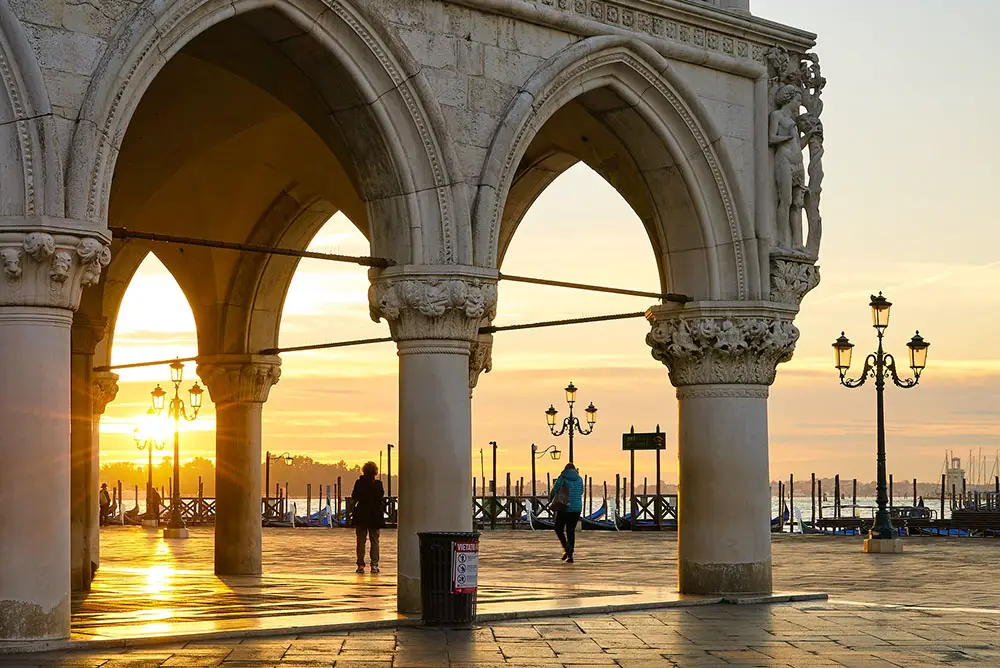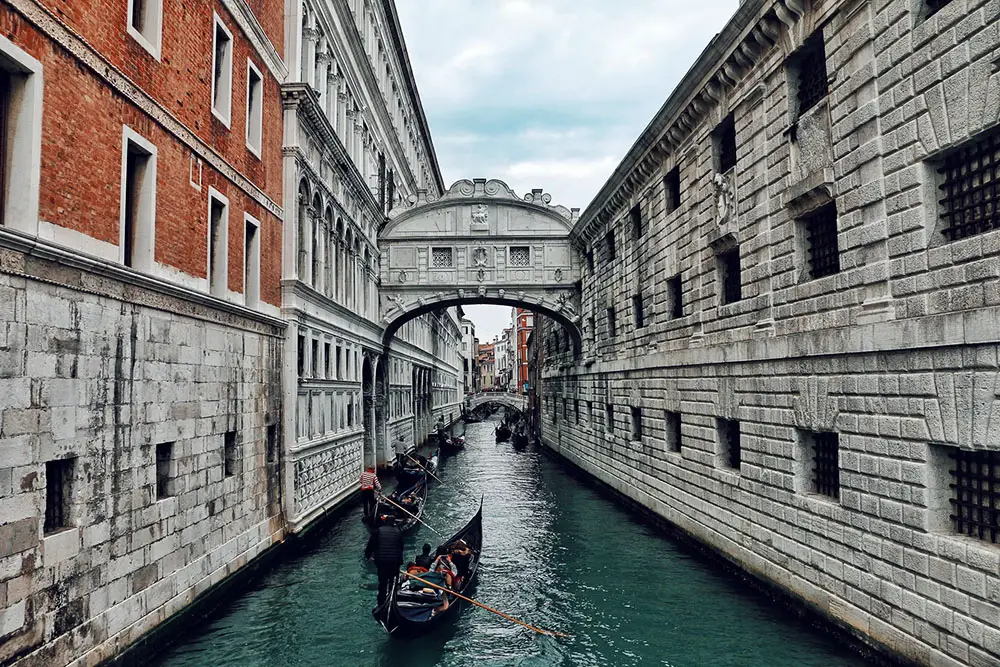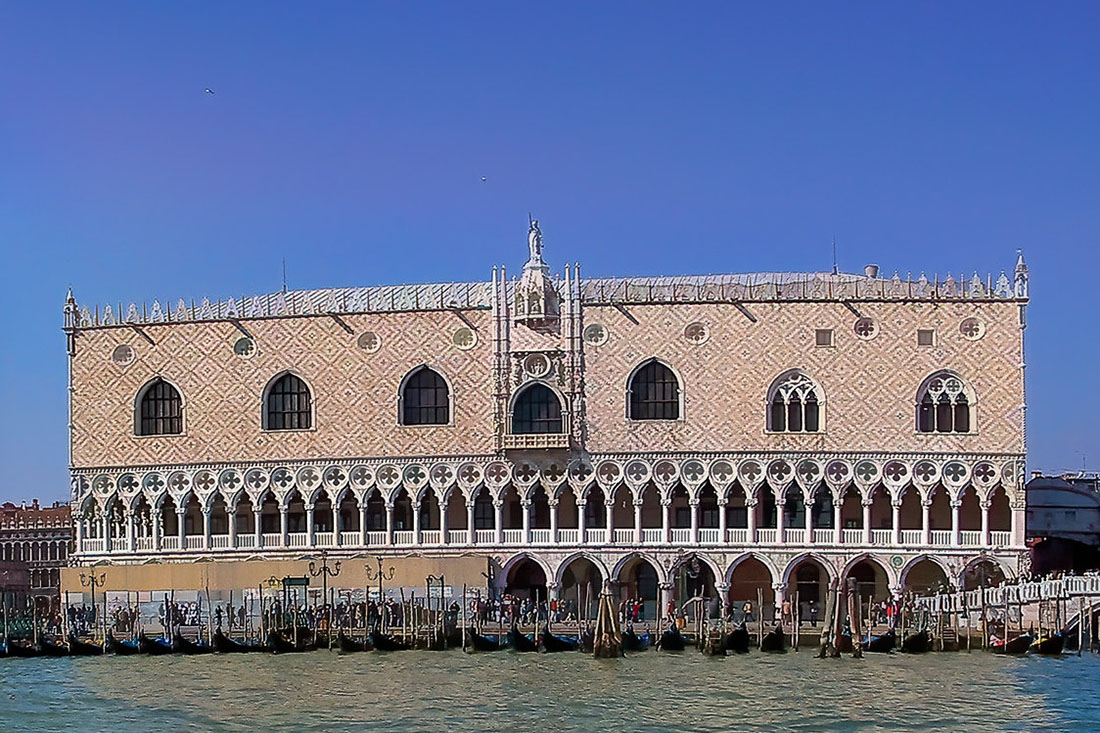Venice is one of the most beautiful cities in the world, and the Palace of Doges (Palazzo Ducale) is one of its main landmarks. This palace was the residence of the Doge of Venice, who was the supreme authority of the former Republic. The palace was built in 1340, and it has been extended and modified over the centuries.
It has been transformed into a museum since 1923 and is today open to visitors and is a popular tourist attraction.
The Doge’s Palace History
Doge’s Palace is a beautiful Venetian Gothic building that sits on the edge of St. Mark’s Basin in Venice, Italy.
The palace was first built in the 9th century but in the 10th century, it was destroyed when a violent fire broke out. It was then rebuilt in the 11th century and has been the home of the Doges of Venice ever since. The Doge’s Palace is one of Venice’s most popular tourist attractions and is known for its stunning architecture, work of art, and rich history.

Visitors to the palace can explore the grandiose staterooms, tour the prison cells, and view the famous Bridge of Sighs. Doge Agnello Participazio moved the seat of government to what is now known as Rialto in 810, and the original 9th-century building was located here before it was destroyed by fire.
The Doge’s palace has since then been rebuilt many times, and one of the first after the fire was Doge Sebastiano Ziani that ruled between 1172-1178. Being a great reformer, St. Mark’s Square (Piazza San Marco) would drastically change the entire layout.
Political changes in the mid-13th century led to the need to re-think the palace’s structure due to the considerably increasing size of the Venetian Great Council, which met in the palace.
The most significant expansion was carried out in the 15th century by Doge Francesco Foscari. He extended the palace to include a wing overlooking the Piazzetta, which served as law courts. This wing also had a ground-floor arcade and first-floor loggias, and the internal courtyard side of the wing was completed with the construction of the Porta della Carta in 1442.
Beginning in 810, the old castle was constructed and has served as the Doge’s Palace and public offices ever since. 120 doges ruled over Venice from the Doge’s Palace for nearly a millennium.
The Doge’s Palace has truly undergone several big changes throughout its history but remains one of Venice’s most iconic landmarks with its gothic style.
Palazzo Ducale Architecture
Doge’s Palace is one of the most iconic buildings in Venice, and its striking design is illuminated beautifully by the sunlight. During the day, the Palace takes on a pinkish hue, thanks to the light reflecting off the white stone.
This effect is particularly pronounced in the evening when the sun sets behind the Palace. At night, the Palace is lit up by artificial light, which gives it a warm, welcoming glow. Visitors to Venice often flock to Piazzetta San Marco to get a glimpse of Doge’s Palace lit up in all its glory.
The exterior of Palazzo Ducale is imposing and grand. The front facade is made of white marble, and it is decorated with intricate carvings symbolising its gothic style.
The entrance is framed by Gothic pinnacles and features two figures of the Cardinal Virtues on each side, with a bust of Mark the Evangelist over which rises a statue of Justice with her traditional symbols of sword and scales.
The Giants Staircase in the courtyard at the Doge’s Palace in Venice is an impressive sight. The Giants Staircase was built in the 14th century and is one of the most famous features of the palace. It is made of white marble and has two landings and is decorated with statues and reliefs where the most prominent ones are Sansovino’s colossal statues depicting Mars and Neptune, representing the power Venice had over both land and sea.
The Giants Staircase leads to the second floor of the palace from where you can see the Grand Canal and the Piazza San Marco.
Bridge of Sighs

The Bridge of Sighs is a covered bridge that spans the Rio di Palazzo and connects the New Prison to the old interrogation rooms in the Doge’s Palace. It gets its name from the tradition that prisoners would take their last sigh as they crossed the bridge on their way to prison cells.
Built in the 16th century, it houses courtrooms for magistrates but now only ruins remain as a reminder of what used to exist there before construction on this new structure began halfway across town near Piazza del Duomo.
Today, the Bridge of Sighs is one of Venice’s most popular tourist attractions. Visitors can enjoy views of the canal below and glimpse what life was like for prisoners in centuries past.
Porta della Carta
The Palace has many other notable features, such as the Porta della Carta, which is a monumental gateway that was built in 1442. The portico of the Palazzo Ducale is decorated with statues of Venice’s patron saints: Mark, Theodore, and George.
The awe-inspiring gateway into the palace, by Giovanni and Bartolomeo Buon, was completed around 1442. This incredible work of art includes an intricately detailed sculpture depicting Doge Francesco Foscari kneeling before his namesake – St Mark’s lion! The whole structure originally featured gold leafing and painting but over time these were lost to history.
The first thing you notice when entering this majestic place is how large it feels; not just physically but emotionally as well. The space opens up and the ceilings are so high that you get a sense of just how powerful the Venetian Republic was. Even though it’s no longer a republic, standing at this gate makes you feel like anything is possible.
Commissioned in the early 4th century AD, the Tetrarchs is a statuesque portrayal of four Roman emperors. Measuring over 11 feet tall, the statue was originally placed on top of a column in front of the Basilica of Saint Mark in Venice. Today, it can be found to the left of Porta della Carta, one of the main entrances to the basilica. The statue is an impressive sight, and its placement near the Basilica of Saint Mark highlights the importance of this Venetian landmark.
Location
Piazza San Marco, Venice
Opening Hours
Open daily from 8.30 am to 5.30 pm.
Between April – October it’s open until 7 pm.
Price
| Adults | € 25 |
| Students (age 6-14) | € 13 |
| Rolling Venice Card | € 14 |
| Children (up to 5 years) | Free |
How to get there
Take the famous venetian Water Buses to either San Zaccaria or San Marco.
Lines 1, 2, 41, 42, 51, N or LN.
Featured image: Ray @ Flickr

